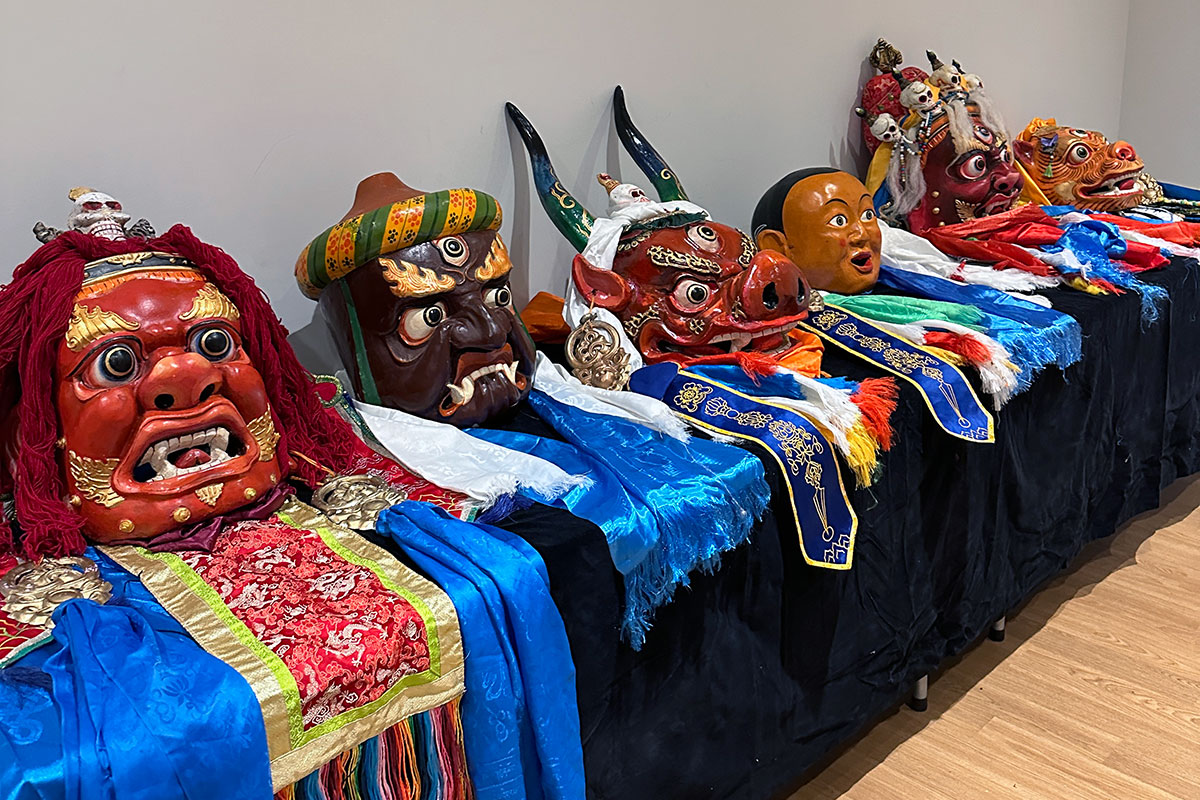It’s likely that if you search for “Mongolia mask maker,” the first name on the list is Gankhuyag Natsag, a Northern Virginia-based artisan and our January National Museum of Asian Art × Folklife Artisan in Residence.
Gankhuyag, known by many as GanNa, was born in 1961 in Ulaanbaatar, Mongolia, and immigrated with his wife to the United States in 2002. A participant in the 2010 Smithsonian Folklife Festival program Asian Pacific Americans: Local Lives, Global Ties, he has spent over two decades traveling around the world to exhibit and share Mongolian culture. With a mission of heritage preservation, he has helped revive the Tsam dance rituals that were banned in the 1930s by Mongolia’s Communist government, and he was named the Mongolian Cultural Ambassador to the United States by the current Mongolian government.


Starting in 1997, GanNa worked for a decade to recreate the 108 masks of the Khuree Tsam, a religious Mongolian festival. He presented the complete mask collection to the public in 2007. Each god in Tsam represents a specific area of life and descends to bring blessings, protect livestock, and intervene in conflicts. Tsam also serves as a conduit for gods to bestow blessings for the upcoming year. The festival’s costumes and dances are an important part of Buddhist rituals. They often symbolize animals, legends, deities, and devils.
“I started traveling with my masks to Western Europe and around the United States to teach the unique techniques I learned from my teachers,” GanNa explained. “It saved the tradition of the Khuree Tsam’s 108 masks. That’s why nowadays we transfer our traditions and unique arts to our next generations.”
GanNa’s work is a commitment to Mongolian traditions influenced by his artisan parents and notable teachers, such as Lama Dashzeveg. He dedicates himself to preserving these legacies.
Each mask takes at least a month to create. GanNa’s creative process involves research, meditation, and inspiration from each deity. He starts with a clay base and then adds many layers of papier-mâché. Once it has dried, he carves it. Finally, the mask is painted, decorated, and accessorized.
During his Smithsonian Artisan in Residence program, he led two mask-making workshops at the National Museum of Asian Art. With newfound skill and patience, the artisans-in-training made small masks inspired by twenty of GanNa’s 108 masks on display and other images of his work.


A large part of GanNa’s practice is support from his family. During his residency, his wife, Munkhbayar, made Mongolian snacks to share at the events. His daughter Maral helped with the public workshops. His son, Zana, who is a local actor, helped with the artisan talk and performance. Zana described growing up with masks in his bedroom and learning about their significance when meeting gods: they each have the power of protection. In 2012, GanNa trained his son as a mask-making apprentice with support from the Virginia Folklife Program.
During GanNa’s weeklong residency, he visited top theaters and props shops in Washington, D.C., including Arena Stage, Woolly Mammoth Theatre, and Shakespeare Theatre Company. Rather than acting like competing organizations, these local theaters form a network to support each other and other artisans. GanNa and his family received private tours and learned how they create props like hats, costumes, and larger sets and stage pieces. At Woolly Mammoth, one staff member recognized Zana as an actor!
Shortly after GanNa completed his residency, he organized an event in Northern Virginia to celebrate the Mongolian Lunar New Year and honor the Year of the Dragon. It hosted over four hundred attendees. His upcoming schedule includes travel to Europe and Asia and continuing projects with the Mongolian Embassy in Washington, D.C.
GanNa has participated in various Smithsonian events since his arrival in the United States, but the residency program felt like a truly collaborative experience.
“Learning from each other and together gave us the best experience,” he reflected. “I feel like a true bearer of legacy!”

Beth Ferraro is the artisan coordinator working with the Center for Folklife and Cultural Heritage and the National Museum of Asian Art Museum on this pilot program. She is the curator at Gallery Y at the YMCA Anthony Bowen in D.C., teaches chair yoga to seniors, and serves as an art and community consultant under the name The Art Island.


